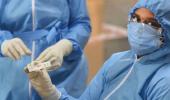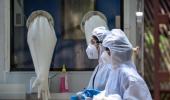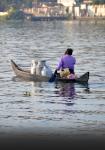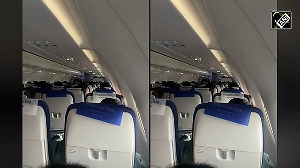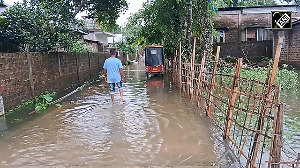'Install the app for yourself and your family.'
'Make sure that everybody you come in contact with on a daily basis -- your drivers, your maids, your colleagues at work -- make sure they too are using the app.'
'Also encourage people who carry some influence, like office managers, to convince their employees to do the same.'
'This only helps in improving your safety levels.'

Lalitesh Katragadda, founder, Indihood, has built crowdsourcing population-scale platforms including Avanti for financial inclusion. Katragadda, former country head, Google India Products, recently worked on the Aarogya Setu app along with a team of 30 volunteers.
"When a crisis like this happens, tech needs to be used judiciously and thoughtfully. It's not a silver bullet," Katragadda tells Rediff.com's Roshneesh K'Maneck in the concluding segment of a two-part interview.
There was a report which said the Aarogya Setu lacks any representation from the ministry of health or any independent involvement of persons with a medical or epidemiological background. Is that true?
That's not true. In fact, the self-assessment system that we are using is entirely following ICMR (Indian Council of Medical Research) guidelines.
So before the launch of the app, the entire self-assessment part was vetted by the relevant authorities in the ministry of health and the ICMR.
And the contact tracing algorithm that we use is also reviewed -- we have an epidemiologist on the team, but I won't reveal his name -- and in addition to that every algorithm that we use is in accordance with the relevant health authorities and the government's epidemiological experts.
As of now, the app is only available on smart phones. As per a report in November 2019, there are 400 million feature phone users in India. Isn't it a worry that the app's reach isn't as expansive as it should be?
Yes, that is true. There are two answers to that. There are some feature phones such as the Jio feature phone, for which we are building an app for. (RIL Chairman) Mukesh Ambani has appointed a team to oversee this effort and they are building an Aarogya Setu app for Jio phone users. So that will cover another 60 million of feature phones.
The second thing is that we are building an Interactive Voice Response System, at least for the self-assessment part, because people need to avail of it when they need help and we need to reach out to people.
So, we are building an IVRS so that people can call and give their symptoms and if they need help, then they can be reached out to and if they are fine, then all is okay.
So you are expanding the app and moving it forward.
Yes, work is happening 24x7. The volunteers aren't sleeping well.
What is worth noting is that you don't need a smart phone for the IVRS, any phone will do.
Contact tracing of this app needs a smart phone. The smart phone is needed only for Bluetooth and GPS tracing and the need for that is much higher in dense, urban areas.
And this is a probabilistic system, meaning the more people the use it, the better it gets and the more people who use it, the safer you are.
I have been looking at the infection data, the infection is spreading faster in the denser areas of India -- the denser the neighbourhood, the faster rate of the infection spreading.
In areas like these, the app has more value.
And I would like to say one thing to your readers -- there are some things you should do to keep yourself safe.
One is installing the app for yourself and your family.
If you have kids who might go to school or something before the vaccine arrives, make sure that your kids have a smart phone when they go out.
Kids do get infected, but they are mostly safe. Children below the age of 20 are at low risk, but they can spread the infection unknowingly.
So everyone must have a smart phone with the app.
And for you to be safe, make sure that everybody you come in contact with on a daily basis -- your drivers, your maids, your colleagues at work -- make sure they too are using the app.
Also encourage people who carry some influence, like office managers, to convince their employees to do the same.
This only helps in improving your safety levels.
You just mentioned that parents must make their children carry their phones with the app on them. I want to clarify a doubt.
Supposed my phone gets exchanged with someone else by mistake, is there a possibility of false data being created?
For instance, I have the virus, but I have exchanged my phone with someone so when you carry out contact tracing it goes through my phone, but in reality it is me who has the virus.
That is actually spot on. People should avoid doing this. But if it does happen, it's not the end of the world.
There are systems in place when contact tracing takes place. People double check. They will call you and see if you have followed the route that is mentioned and so on.
There might be some false positives, but it doesn't hurt anything. It's just waste of information.
Do you plan to market this app or its variants to other governments?
Currently we are focusing on making sure India is safe.
This app has only around 60 plus million downloads. But Indian urban and wealth areas become safe once we cross 200 million. And there is lot more to be done.
But having said that, if someone does reach out, the Indian government is always there to help.
There is a report that the app, which is being used in China, provides the user with a COVID-19 negative certificate which is then used for verification for public transport. Is that something you are considering for the app?
Well, we are introducing something on the same lines.
If you have a pass to travel around for essential services, the new feature can show it on the phone or through any other means.
Having said that, the colour scheme -- orange, yellow green -- on the app is up to the local authorities if they want to make it mandatory.
We are a very different government than China. It is not mandated by the government.
On a larger scale, what do you think is the role that technology should play in times of a pandemic? Do you think tech can help in the future to prevent such a situation to occur again?
It's a very deep question. When a crisis like this happens, tech needs to be used judiciously and thoughtfully. It's not a silver bullet.
Just by using Aarogya Setu you don't become safe. It is one of the layers you need to use to become safe.
You still need to maintain social distance, wash your hands, wear a mask and so on. This doesn't solve the problem.
And in this particular crisis, the most important thing we need to do is to make sure that older people stay indoors and stay away from others.
Once we start going out to work, we should maintain social distancing with them because they are at high risk.
 You have to be focused on the biology of this problem because technology can solve technical problems, it cannot solve biology.
You have to be focused on the biology of this problem because technology can solve technical problems, it cannot solve biology.
Having said that, I think the tech solutions we are building, not just Aarogya Setu, but others too, are very useful.
They are enablers, especially to address India's population scale.
Even though they are helpful, there still only make up 10 to 20 per cent of the solution. They are not a 100 per cent of the solution.
All the other things such as testing, needs to happen at scale. And tech can help gather the data and help testing to grow.
Another thing that needs to happen is the health infrastructure needs to be ready and hats off to the doctors and nurses at the frontline. Those are the things that matter.
Tech is an additional shield, an additional source of support to those who support us.
But the other question you asked is, how do you prevent such a situation from occurring again? I think for that it requires society and the world to wake up a little bit.
This thing happened because an infection jumped from an animal to people. And this is not the first time that this is happened, we don't learn from that.
If we keep devastating our forests and the animals keep coming out, we have to be more thoughtful about that.
The cost of this infection and other previous ones like SARS and H1N1 have had an impact on society because of the way we treat our animals and our animal practices. Those have to be rethought.
Another particular thing about this infection is that every country thinks they can do their own. But you can do that. Because the consequences are far-reaching.
How to actually solve this problem, I don't know. I don't think technology can solve this problem. I think a lot has to be done through conversation, diplomacy and willpower.
Have you been compensated by the government for the development of this app?
No, we are volunteers. All volunteers involved -- including Deep Kalra of MakemyTrip who has the bunch of engineers working on this -- and it is all being done pro bono.
The software is being donated to NIC, the government owns it and we are making sure that we are contributing to the cause. We have no stake in this.
Has this project been the most satisfying thing you have done in your professional life?
I think you should ask me this question nine months from now.
I think I will definitely be more satisfied if more than 200 million people use the app. And if we find people who will help use all these tools that we just mentioned.
So currently we are still working, work is in progress. It is only satisfying if people use it.
Otherwise, we are building technology which may be interesting, but not satisfying.
